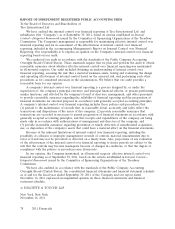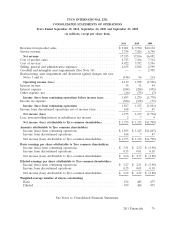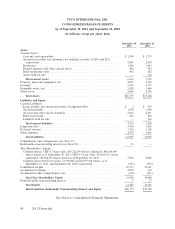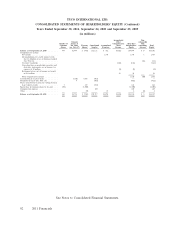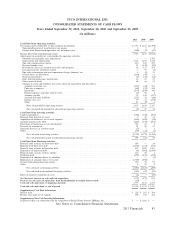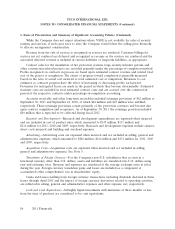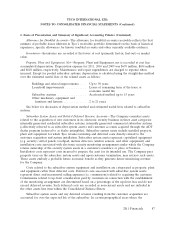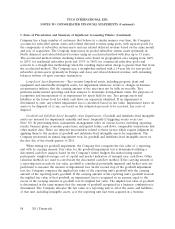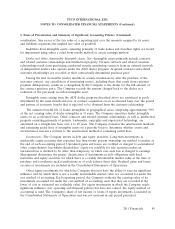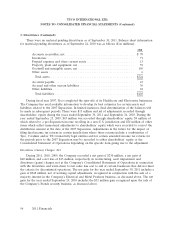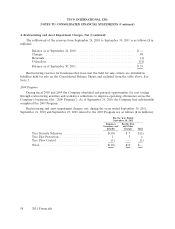ADT 2011 Annual Report Download - page 191
Download and view the complete annual report
Please find page 191 of the 2011 ADT annual report below. You can navigate through the pages in the report by either clicking on the pages listed below, or by using the keyword search tool below to find specific information within the annual report.TYCO INTERNATIONAL LTD.
NOTES TO CONSOLIDATED FINANCIAL STATEMENTS (Continued)
1. Basis of Presentation and Summary of Significant Accounting Policies (Continued)
Company has a large number of customers that behave in a similar manner over time, the Company
accounts for subscriber system assets and related deferred revenue using pools, with separate pools for
the components of subscriber system assets and any related deferred revenue based on the same month
and year of acquisition. The Company depreciates its pooled subscriber system assets (primarily in
North America) and related deferred revenue using an accelerated method with lives up to 15 years.
The accelerated method utilizes declining balance rates based on geographical area ranging from 160%
to 265% for residential subscriber pools and 135% to 360% for commercial subscriber pools and
converts to a straight-line methodology when the resulting depreciation charge is greater than that from
the accelerated method. The Company uses a straight-line method with a 14-year life for non-pooled
subscriber system assets (primarily in Europe and Asia) and related deferred revenue, with remaining
balances written off upon customer termination.
Long-Lived Asset Impairments—Tyco reviews long-lived assets, including property, plant and
equipment and amortizable intangible assets, for impairment whenever events or changes in business
circumstances indicate that the carrying amount of the asset may not be fully recoverable. Tyco
performs undiscounted operating cash flow analyses to determine if impairment exists. For purposes of
recognition and measurement of an impairment for assets held for use, Tyco groups assets and
liabilities at the lowest level for which cash flows are separately identified. If an impairment is
determined to exist, any related impairment loss is calculated based on fair value. Impairment losses on
assets to be disposed of, if any, are based on the estimated proceeds to be received, less costs of
disposal.
Goodwill and Indefinite-Lived Intangible Asset Impairments—Goodwill and indefinite-lived intangible
assets are assessed for impairment annually and more frequently if triggering events occur (see
Note 10). In performing these assessments, management relies on various factors, including operating
results, business plans, economic projections, anticipated future cash flows, comparable transactions and
other market data. There are inherent uncertainties related to these factors which require judgment in
applying them to the analysis of goodwill and indefinite-lived intangible assets for impairment. The
Company performed its annual impairment tests for goodwill and indefinite-lived intangible assets on
the first day of the fourth quarter of 2011.
When testing for goodwill impairment, the Company first compares the fair value of a reporting
unit with its carrying amount. Fair value for the goodwill impairment test is determined utilizing a
discounted cash flow analysis based on the Company’s future budgets discounted using market
participants’ weighted-average cost of capital and market indicators of terminal year cash flows. Other
valuation methods are used to corroborate the discounted cash flow method. If the carrying amount of
a reporting unit exceeds its fair value, goodwill is considered potentially impaired and further tests are
performed to measure the amount of impairment loss. In the second step of the goodwill impairment
test, the Company compares the implied fair value of the reporting unit’s goodwill with the carrying
amount of the reporting unit’s goodwill. If the carrying amount of the reporting unit’s goodwill exceeds
the implied fair value of that goodwill, an impairment loss is recognized in an amount equal to the
excess of the carrying amount of goodwill over its implied fair value. The implied fair value of goodwill
is determined in the same manner that the amount of goodwill recognized in a business combination is
determined. The Company allocates the fair value of a reporting unit to all of the assets and liabilities
of that unit, including intangible assets, as if the reporting unit had been acquired in a business
88 2011 Financials


